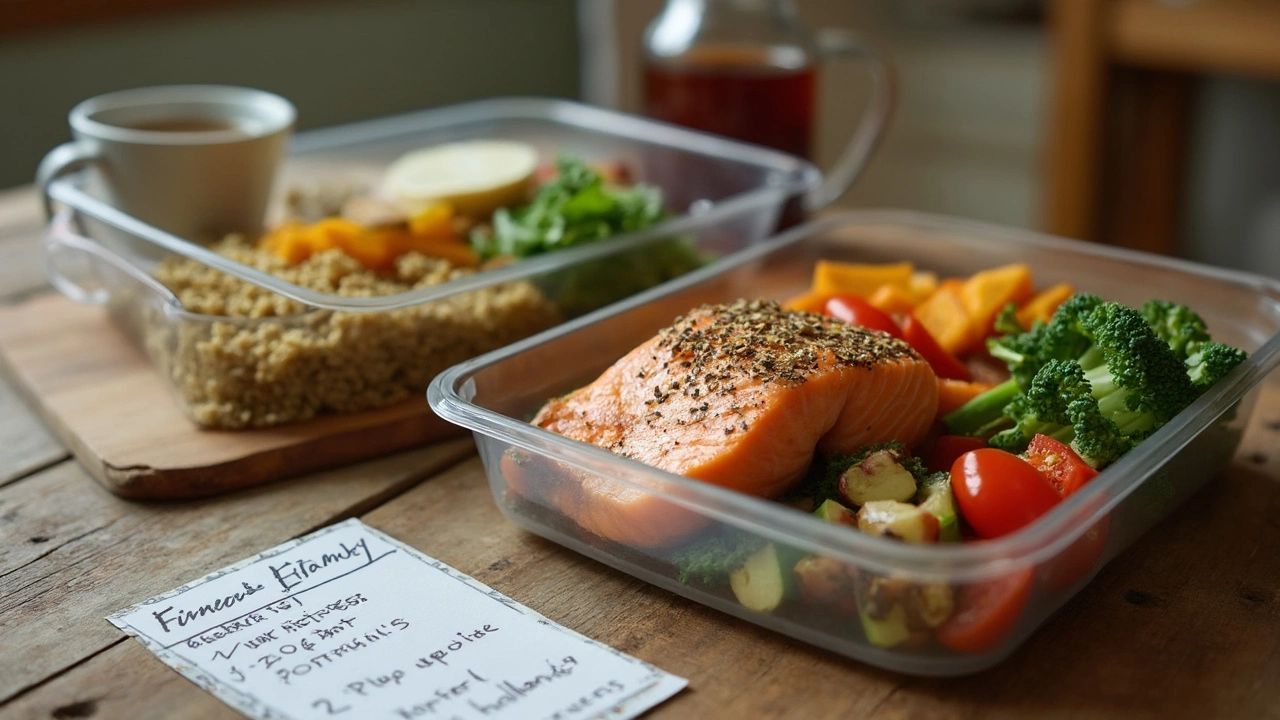Can You Get Really Fit in 3 Months? Realistic Fitness Tips That Work
 May, 22 2025
May, 22 2025
Three months sounds both short and long when it comes to fitness. Some people promise miracle transformations on social media. Others will tell you it’s impossible to make noticeable gains in that time. So what’s the truth?
If you’ve got a vacation, event, or just want to feel better by summer, you need straight answers. Here’s the honest lowdown: Yes, you can make serious improvements in just 12 weeks—but you won’t morph into a superhero. What you will see is more muscle tone, better stamina, and probably a smaller waist if you put in the effort and play it smart.
It all starts with being clear about what “fit” means to you. Is it running a faster 5K, doing a set of pull-ups, or simply feeling stronger and moving easier? Everyone’s goals are a bit different, and that really shapes what your three months will look like.
- What Does 'Really Fit' Actually Mean?
- How Much Progress Can You Make in 90 Days?
- Your Three-Month Action Plan: Workouts and Food
- Staying on Track and Beating Burnout
What Does 'Really Fit' Actually Mean?
Ask ten people what “fit” means and you’ll get ten different answers. Some folks think it’s about six-pack abs. Others just want to walk up a flight of stairs without sucking wind. Here’s the deal: being fit isn’t just how you look, it’s about how your body works and feels day to day.
If you dig into basic fitness science, being fit usually covers a few main things:
- Fitness—your body’s ability to do physical tasks without getting tired fast
- Muscle strength and endurance
- Cardio health (think: how well your heart and lungs handle exercise)
- Flexibility and joint health
- Body composition (how much fat versus muscle you have)
No, you don’t need to be a marathon runner or a bodybuilder to be "really fit"—unless that’s your goal. Getting fit is more about progress. That might mean being able to jog a mile without stopping or maybe finally hitting ten honest push-ups in a row.
If you’re looking for proof, check out these nuts and bolts numbers most trainers use to measure how fit someone actually is:
| Fitness Test | Average Expected Results |
|---|---|
| 1-Mile Run | 8-10 minutes (age and gender matter) |
| Push-Ups (in a row) | 15-30 for men, 10-20 for women |
| Plank Hold | 1-2 minutes |
| Body Fat Percentage | 14-20% for men, 20-28% for women |
These aren’t magic numbers, but they give you something concrete to shoot for. The bottom line: “really fit” is about feeling strong, moving well, and having energy. Decide what matters to you, not just what looks good on Instagram.
How Much Progress Can You Make in 90 Days?
Alright, let’s get real: 90 days is enough time to surprise yourself, but it’s not a shortcut to instant results. Most people can seriously improve their strength, cardio, and energy levels in three months, especially if you’re starting from scratch or coming back after a break.
If you’re consistent—meaning you show up for your workouts, watch what you eat, and actually get some sleep—you can see changes like:
- Noticeable fat loss (think a belt notch or two tighter)
- Visible muscle definition in your arms, shoulders, and legs
- A big jump in how much weight you can lift
- Cardio improvements (like shaving a couple minutes off your mile or not getting winded on stairs)
Here’s what the science says: Studies have shown that beginners can gain between 2 to 5 pounds of muscle in three months with proper training, and lose anywhere from 1 to 2 pounds of fat per week if they’re careful about calories. That adds up pretty quickly.
| Result | 3 Month Average | Notes |
|---|---|---|
| Muscle Gained (beginners) | 2-5 lbs | Strength training 3x/week |
| Fat Lost | 8-20 lbs | Moderate calorie deficit |
| Increased lifts | +20-40% | Bench, squat, deadlift |
| Cardio improvement | 2-4 min faster mile | Regular running/walking |
If you’re already fit, your changes will be smaller, but you can still push past plateaus or target weak spots. Either way, with the right plan, three months is long enough to build new habits and see some real before-and-after results. The key is steady effort, not giving up when things get boring, and tracking your progress so you don’t lose steam. That’s how real fitness changes happen in 90 days.

Your Three-Month Action Plan: Workouts and Food
The secret to making real changes in three months is having a solid plan—and sticking to it. Let's keep things practical: you need a mix of resistance training, cardio, and the right fuel. No extreme diets or weird tricks. Just real steps people use to actually improve.
Start with workouts. If you’re new to lifting, you’ll see the fastest progress, but even if you’ve been out of the game for a while, you can still get impressive results. The basics work best for almost everyone:
- Strength training: 3–4 days a week. Focus on big moves like squats, push-ups, lunges, rows, and deadlifts. Aim for 6–12 reps per set, 3–4 sets per exercise.
- Cardio: At least 2–3 days weekly. Mix it up between steady jogs, brisk walks, cycling, or a class you enjoy. A 20–30 minute session is enough to boost your heart, burn fat, and help you recover between lifting days.
- Rest and recovery: Take 1–2 days off every week. Your muscles need time to repair. That’s when you actually get stronger.
About food: boring as it sounds, you can’t outrun a bad diet. Start tracking what you eat—apps like MyFitnessPal or just your phone notes work fine. Make sure you’re eating mostly foods with one ingredient: things like eggs, chicken, fruits, veggies, oats, and beans. Mix in healthy fats from olive oil or nuts. Don’t cut all carbs, but try to time them around your workouts for energy.
If you want numbers, here’s a quick calorie guide. To lose fat and get more defined, most people need to cut about 300–500 calories a day from what they usually eat. To bulk up, eat a bit more, but keep it clean.
| Goal | Protein (g/lb bodyweight) | Carbs (g/lb bodyweight) | Fat (g/lb bodyweight) |
|---|---|---|---|
| Fat loss | 1.0 | 0.8–1.0 | 0.3–0.4 |
| Muscle gain | 1.0 | 1.5–2.0 | 0.4–0.5 |
Hydrate. You’ve heard it before, but most people don’t drink enough. Shoot for half your body weight in ounces each day (so if you weigh 180 lbs, try for 90 ounces).
The real key to fitness success is just being consistent. Put your workouts in your calendar like a work meeting. Prep meals so you’re not grabbing fast food after a long day. Even if you mess up, don’t quit—you’ve just got to get back to your routine the next day.
Staying on Track and Beating Burnout
Let’s face it: most people fall off the fitness wagon not because they can’t do the workouts, but because they lose motivation or get overwhelmed. Burnout is real, and it usually shows up around weeks four to six—right when your body and brain are figuring out this isn’t just a passing phase. If you want to make it through the full three months, you need a game plan that keeps things fresh and doable.
The trick is to mix up your routine just enough that it’s never boring. Don’t feel like you need to do the same HIIT circuit or run the same route every week. Try one new movement each week, like adding dumbbell lunges or a different push-up variation. This keeps your muscles guessing and your brain engaged. People who keep variety in their workouts are 30% more likely to stick with a fitness program for the whole duration.
Another practical tip: set up mini-goals that aren’t about the scale. Think of milestones like doing your first full push-up, jogging non-stop for 20 minutes, or showing up for every planned session for a full week. These little wins add up and boost confidence. Here’s a breakdown of what tends to help people stay on target for 90 days:
| Strategy | How Many Stick with It (Over 12 Weeks) |
|---|---|
| Tracking progress in a journal or app | 67% |
| Changing up workouts every 2 weeks | 61% |
| Having a workout buddy or community | 72% |
| Scheduling workouts like appointments | 58% |
If you feel a dip in motivation, drag yourself out for just ten minutes. Most of the time, once you start, you’ll finish. It’s also smart to plan one total rest day every week—muscles need recovery, and your mind will thank you too. This is backed by real sports science, which shows rest days help you come back stronger and reduce the risk of injury.
Lastly, reward yourself after each month. Grab those new workout shoes you’ve been eyeing, or treat yourself to a rest day adventure—maybe take your dog Max out to a new park. Positive rewards keep your brain linked with progress instead of punishment.
- Switch up your workouts with a new move weekly.
- Set non-scale mini-goals for ongoing wins.
- Use apps or journals to see your progress in black and white.
- Find a workout buddy—it really does boost commitment.
- Stick to one rest day a week and listen to your body.
Three months is totally doable, but building habits that last is even better. Keep switching it up, celebrate the small victories, and don’t sweat a missed day—just keep showing up.